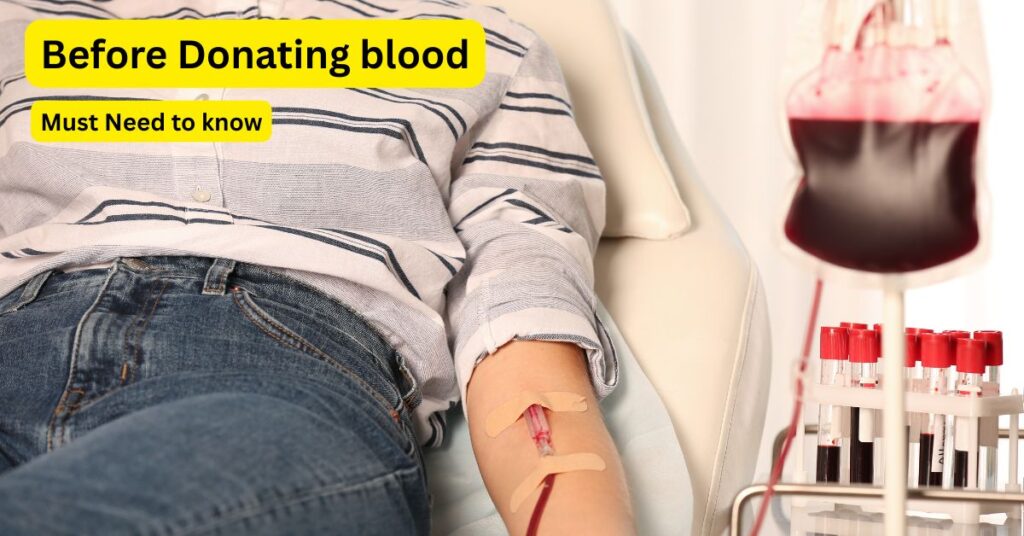
The red blood donation is among the strongest pieces of kindness you can do. However, there are some important details about what you should do before giving blood, what the pros of giving the blood are, and what the possible side effects are before you roll up your sleeve. This guide takes you through all you require in a step-by-step manner.
1. Things to Do Before Donating Blood
- Drink Water and Sleep
Consume some 16 oz of water the day before and eschew alcohol or coffee. 7-9 hours of sleep is the optimal result to aim for
- Feed a Healthy iron-rich meal
Fill up with leafy vegetables, beans, lean meat, and citrus fruits in a bid to boost iron and keep the blood pressure stable
- Avoid Saturated Food & Smoking
Avoid burgers, fries, and cigarettes in the two hours before donation at least, because they influence the quality and flow of blood
- Prepare Essentials
Bring an ID, a rank short-sleeved comfortable shirt, bring a list of medications with you
2. Benefits of Donating Blood
- Potential Heart Health Improvement
Regular donors may experience better blood viscosity and reduced iron overload, which benefits cardiovascular health, though studies vary
- Free Mini Health Check-Up
Every donation includes measurement of your pulse, hemoglobin, blood pressure, and infection screening
- Emotional Satisfaction
Helping others releases endorphins, enhancing well-being
- Iron Balance & Detoxification
Can help reduce excess iron levels (good for hemochromatosis) and lower toxins like PFAS
3. Common Side Effects & Risks
- Bruising or Minor Bleeding
Up to 10% of donors experience bruising or slight bleeding at the needle site
- Dizziness, Nausea, or Fainting
Low blood pressure can cause lightheadedness—sit or lie down until it passes
- Fatigue & Weakness
These tend to last a few days as your red blood cells replenish
Stanford Blood Center
- Rare Complications (<1 in 10,000)
Nerve injury, infection, or citrate reactions during apheresis are extremely uncommon
4. Care Immediately After Donating
- Snack & Hydrate
Spend 10–15 minutes drinking fluids and eating a light snack
- Avoid Strenuous Activity
No heavy lifting or vigorous workouts for at least 24 hours
- Keep the Bandage On
Leave it on for several hours; clean the area gently
- Continue Eating & Hydrating
Focus on iron-rich foods post-donation and add extra water to speed recovery
5. When You Can Donate Again
Whole Blood: Every 56 days
Platelets/Plasma: Every week (platelets), every 48 hours (plasma)
Being aware allows you to know what to do before donating blood, ensuring your experience is safe, satisfying, and potentially beneficial to both the recipient and yourself. It can be a force of kindness with the health (iron balance to emotion pick-me-up) benefits, running on depleted energy. All you need to do is remember that the side effects are generally mild and can be prevented through proper care. Be ready, be safe-and proud of your life-saving contribution!
FAQ About Donating Blood.
Yes-have a good meal, one that is of non-fatty foods and rich in iron so as not to faint or feel low on blood pressure.
The majority of healthy children and adults between 16 and 17+ years and a minimum of 50kg are qualified, although screening questionnaires make the final decisions.
Minor effects such as tiredness or light-headedness can persist for several hours or days,s but a quick recovery is sustained.
It is possible to contribute whole blood after every 56 days, platelets after a week, and plasma after every 48 hours.
Less than 0.01 percent of donations cause serious problems such as infection or nerve damage.